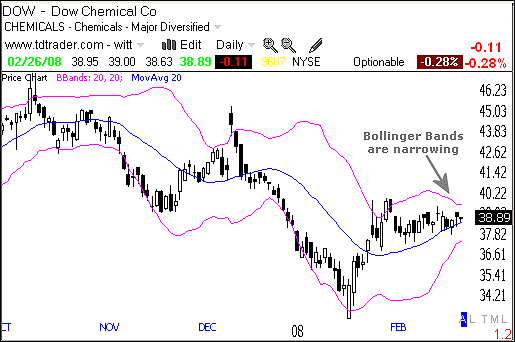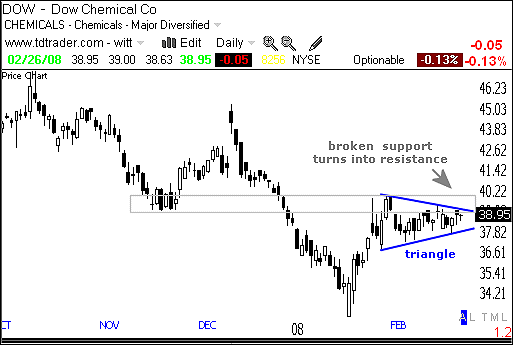
HOT TOPICS LIST
- MACD
- Fibonacci
- RSI
- Gann
- ADXR
- Stochastics
- Volume
- Triangles
- Futures
- Cycles
- Volatility
- ZIGZAG
- MESA
- Retracement
- Aroon
INDICATORS LIST
LIST OF TOPICS
PRINT THIS ARTICLE
by Arthur Hill
After a big surge at the end of January, Dow Chemical moved into a trading range that has tightened over the last few weeks. This volatility contraction could precede a volatility expansion and a significant move.
Position: Hold
Arthur Hill
Arthur Hill is currently editor of TDTrader.com, a website specializing in trading strategies, sector/industry specific breadth stats and overall technical analysis. He passed the Society of Technical Analysts (STA London) diploma exam with distinction is a Certified Financial Technician (CFTe). Prior to TD Trader, he was the Chief Technical Analyst for Stockcharts.com and the main contributor to the ChartSchool.
PRINT THIS ARTICLE
BOLLINGER BANDS
Dow Chemical Is Wound Tight
02/26/08 11:15:58 AMby Arthur Hill
After a big surge at the end of January, Dow Chemical moved into a trading range that has tightened over the last few weeks. This volatility contraction could precede a volatility expansion and a significant move.
Position: Hold
| Figure 1 shows daily candlesticks with the Bollinger Bands indicator. The middle line is the 20-day moving average (blue). The upper band is two standard deviations above and the lower band is two standard deviations below (pink lines). These bands reflect underlying volatility. They expand when volatility increases and contract when volatility decreases. |

|
| FIGURE 1: DOW CHEMICAL, DAILY. Shown are daily candlesticks with the Bollinger Bands indicator. The middle line is the 20-day moving average (blue), and the upper band is two standard deviations above and the lower band is two deviations below (pink lines). |
| Graphic provided by: TeleChart2007. |
| |
| The Bollinger Bands expanded in January as the stock fell sharply. A rebound followed this decline and the exchange traded fund (ETF) then moved into a trading range. Volatility contracted during this trading range and the Bollinger Bands narrowed considerably (gray arrow). This narrowing acts as the calm before the storm and we must now look for a range break. |
| Figure 2 shows a triangle consolidation at resistance. Dow broke support with the January decline and broken support turned into resistance in late January (gray rectangle). The stock stalled at this resistance area over the last four weeks and formed a triangle. These boundaries hold the clue to the next signal. |

|
| FIGURE 2: DOW CHEMICAL, DAILY. Here's a triangle consolidation at resistance. The stock broke support with the January decline and broken support turned into resistance in late January (gray rectangle). |
| Graphic provided by: TeleChart2007. |
| |
| A break above the February high would be bullish, while a break below the February low would be bearish. An upside breakout would signal a continuation of the January surge and target further strength toward the next resistance area around 45. A downside breakout would target a move back toward the January lows. |
Arthur Hill is currently editor of TDTrader.com, a website specializing in trading strategies, sector/industry specific breadth stats and overall technical analysis. He passed the Society of Technical Analysts (STA London) diploma exam with distinction is a Certified Financial Technician (CFTe). Prior to TD Trader, he was the Chief Technical Analyst for Stockcharts.com and the main contributor to the ChartSchool.
| Title: | Editor |
| Company: | TDTrader.com |
| Address: | Willem Geetsstraat 17 |
| Mechelen, B2800 | |
| Phone # for sales: | 3215345465 |
| Website: | www.tdtrader.com |
| E-mail address: | arthurh@tdtrader.com |
Traders' Resource Links | |
| TDTrader.com has not added any product or service information to TRADERS' RESOURCE. | |
Click here for more information about our publications!
PRINT THIS ARTICLE

Request Information From Our Sponsors
- StockCharts.com, Inc.
- Candle Patterns
- Candlestick Charting Explained
- Intermarket Technical Analysis
- John Murphy on Chart Analysis
- John Murphy's Chart Pattern Recognition
- John Murphy's Market Message
- MurphyExplainsMarketAnalysis-Intermarket Analysis
- MurphyExplainsMarketAnalysis-Visual Analysis
- StockCharts.com
- Technical Analysis of the Financial Markets
- The Visual Investor
- VectorVest, Inc.
- Executive Premier Workshop
- One-Day Options Course
- OptionsPro
- Retirement Income Workshop
- Sure-Fire Trading Systems (VectorVest, Inc.)
- Trading as a Business Workshop
- VectorVest 7 EOD
- VectorVest 7 RealTime/IntraDay
- VectorVest AutoTester
- VectorVest Educational Services
- VectorVest OnLine
- VectorVest Options Analyzer
- VectorVest ProGraphics v6.0
- VectorVest ProTrader 7
- VectorVest RealTime Derby Tool
- VectorVest Simulator
- VectorVest Variator
- VectorVest Watchdog
